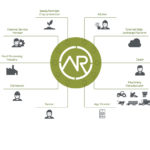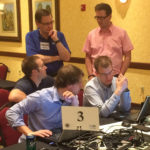Improving the User Experience in a Multi-brand Environment
Farmers and contractors expect that their machinery, precision farming technologies, and farm management systems are all compatible and work seamlessly.

Improving the User Experience in a Multi-brand Environment
Farmers and contractors expect that their machinery, precision farming technologies, and farm management systems are all compatible and work seamlessly.A Mixed Fleet is a Common Situation
Farmers and contractors are seeking to make the best use of their resources. Providing them with the best machinery for their needs is our goal. But depending on the farmer’s business, region and personal preferences, he might need to choose machines and technology systems from different suppliers. In addition, many farmers regularly share rarely used or expensive machinery among themselves. Contractors deal with a variety of farms every day and are challenged with multiple precision farming and invoicing systems, which they are expected to interface with. As Dave Kanicki points out in a recent article in Precision Farming Dealer, “Trying to fit rainbow equipment together can at times be like trying to put together a thousand piece puzzle, with several missing pieces.” (Note: you will need a Precision Farming Dealer account or complete a registration form in order to access the free report.)
Our customers expect that their choice of machinery, and also precision farming technologies and farm management systems, are compatible with each other and work seamlessly. AGCO offers a variety of brands and machine types and therefore is a mixed fleet itself, so we understand the importance of solutions for mixed-fleet farming operations.
Standardized Interfaces are Key
When talking about mixed fleets, a discussion about interfaces comes up quickly. A company with a global presence and a full range of agricultural equipment might want to develop proprietary, company-specific interfaces between implements, tractors, self-propelled machines and the farm office. Proprietary interfaces are easier to set up and maintain than talking to competitors to define common standards. Also, proprietary interfaces can be used to lock the customer into a closed loop environment.
AGCO is convinced that the effort to agree on global standards for interfaces is the right way to ensure a seamless compatibility between all machines and farm management systems on the farm. Detailed record keeping of farming operations for farm optimization and reporting purposes, as well as new trends like machine-to-machine communication or autonomous operations, require different systems to extensively interact with each other. This is only possible with standardized interfaces and communication methods. The Agricultural Industry Electronics Foundation (AEF) brings big and small players together to ensure global ISOBUS guidelines and standards are available and being used in a consistent way.
While it is obvious that the technical interface between machines needs to be harmonized to allow for seamless compatibility, another interface is equally important when discussing mixed fleets. The human-machine-interface (HMI) is key for the operator to interact with the machine. A good HMI lets the operator experience a sense of control over the operation and creates the feeling that it is helping to increase overall efficiency. A bad HMI on the other hand results in frustration and the feeling of wasting time.
Technical interfaces are usually being defined by technical experts with an objective definition of “it works”. For the customer as well, the solution either works or not. But when talking about HMI, we immediately use terms like “sense” or “feeling”, indicating that a HMI gets judged on a subjective level. Although there are standards like the DIN EN ISO 9241 to help defining the usability of a product, every operator has a different background and therefore a different belief for what a good HMI looks like. As a result, it is not possible to come up with one common HMI solution that works for every operator globally.
AGCO’s Approach to Human-Machine-Interfaces
Agricultural machinery is designed and built to last for a long time, and is sometimes being used for decades. About 15-20 years ago, graphical HMIs began to spread out on agricultural machinery. At that time, the HMI was machine centric and the operator had to understand how the machine technically worked in order to understand the graphical user interface. Limitations in computing power and software frameworks led to the availability of a rather basic functional range.
In the meantime, hard- and software development cycles in the computing industry have become shorter and computing power is ubiquitously available. Operators of agricultural machinery are used to the latest tablet PCs, smart phones and cloud applications on demand and expect a new machine to be on a similar level. This includes again technical communication interfaces between smart device and machine (bring your own device approach) for machine setup, web browsing, hands-free speaking, music streaming and the use of apps. But it also includes the expectation to have up to date human-machine-interfaces on the machine. Operating systems for PCs and smart devices are globally available and therefore create a benchmark for other industries, as the HMIs become more streamlined.
The above described conflict of goals between machine lifecycle and the lifecycle of personal electronics is being approached by AGCO through frequent updates of machine software in the field which keeps the technical interfaces and HMI up to date. And certainly new machine developments include the latest hard- and software developments.
Another topic is the trend to move away from machine centric to operator centric HMIs, which actively support the operator through increased automation and suggestions for improvements, so the machine learns to understand the user.
The integration of personal devices in the machine is important not only for phone calls and infotainment but also for allowing an increased display area in the cab for precision farming features and machine control purposes.
AGCO sees high value in brand specific HMI developments. Each brand has a history in how to operate the machines, and loyal customers are used to these approaches. In AGCO, a dedicated product owner coordinates HMI definitions and brand differentiation globally. While HMIs widely remain brand specific, it is important to use standardized icons and symbols (e.g. ISO 7000) to avoid misunderstandings and make it easier to switch from one machine to another. Also, it is of high importance to provide high quality translations of display menus to the operator. AGCO provides up to 26 languages on a display to help the operator in any region to concentrate on his task.

HMI brand differentiation at Fendt, Massey Ferguson and Valtra: unique but still following common standards
Limitations of Seamless Compatibility
In addition to the aforementioned limitations in computing power and the resulting constraints in updating machines in the field with completely new features and HMIs, the lack of standardization in many areas prevents further compatibility in mixed-fleet operations. One example is the transfer of geo-data from one machine to another in a mixed-fleet environment. Although AGCO and FarmFacts have developed a web-based wayline converter tool to provide the possibility to convert straight waylines and boundaries between major formats, this is not seamless and requires know-how about the different formats. Another example for missing standards is the exchange of telemetry data between machines in the field and different telemetry systems in the cloud or in the farm office.
Regarding HMI, customers are expecting a more modern graphical interface with ISOBUS implements. Also, it is a challenge for the agriculture industry to increase the ease of use of HMIs while in parallel the functional range of the devices is expanding as well.
AGCO is working hard to surpass the demands of our customers including the user-experience in a multi-brand environment. To learn more about how AGCO is connecting the mixed fleet, visit https://www.agcotechnologies.com/.
Written by Adrian Hackfort
Adrian Hackfort is the product manager for Fuse global on-board technologies including guidance systems, ISOBUS tractor-implement communication as well as displays & user interfaces.




